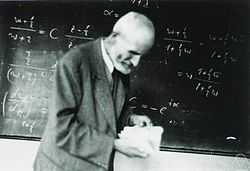Oskar Perron
From Wikipedia, the free encyclopedia
| Oskar Perron | |
|---|---|
 Perron in 1948 Photo courtesy MFO | |
| Born |
May 7, 1880 Frankenthal |
| Died |
February 22, 1975 (aged 94) Munich |
| Nationality | German |
| Fields | Mathematics |
| Institutions |
University of Heidelberg University of Munich |
| Alma mater | University of Munich |
| Doctoral advisor | Ferdinand von Lindemann |
| Doctoral students |
Josef Heinhold Helmut Röhrl Hermann Schmidt Georgi Bradistilov |
Oskar Perron (7 May 1880 – 22 February 1975) was a German mathematician.
He was a professor at the University of Heidelberg from 1914 to 1922 and at the University of Munich from 1922 to 1951. He made numerous contributions to differential equations and partial differential equations, including the Perron method to solve the Dirichlet problem for elliptic partial differential equations. He wrote an encyclopedic book on continued fractions Die Lehre von den Kettenbrüchen. He introduced Perron's paradox:
- Let N be the largest integer. If N > 1, then N2 > N, contradicting the definition of N. Hence N = 1
to illustrate the danger of assuming that the solution of an optimization problem exists.
Works
- Über die Drehung eines starren Körpers um seinen Schwerpunkt bei Wirkung äußerer Kräfte, Diss. München 1902
- Grundlagen für eine Theorie der Jacobischen Kettenbruchalgorithmus, Habilitationsschrift Leipzig 1906
- Die Lehre von den Kettenbrüchen, 2 vols., 1913, 3rd edn. Teubner Verlag 1954 (vol. 1 Elementare Kettenbrüche,[1] vol. 2 analytische und funktionentheoretische Kettenbrüche[2])
- Irrationalzahlen, 1921,[3] 4th edn. de Gruyter, Berlin 1960
- Algebra I, II, Sammlung Göschen 1927,[4] 3rd edn, 1951
- with Evelyn Frank: "Remark on a certain class of continued fractions". Proc. Amer. Math. Soc. 5 (2): 270–283. 1954. MR 0061185.
- Nichteuklidische Elementargeometrie der Ebene, Teubner, Stuttgart 1962
Sources
- Edmund Hlawka: Das Werk Perrons auf dem Gebiete der diophantischen Approximationen. Jahresbericht der DMV 80, 1978, S. 1–12
- Josef Heinhold: Oskar Perron, Jahresbericht der DMV 90, 1988, S. 184–199 (in der DML Bielefeld: )
- Freddy Litten: Oskar Perron – Ein Beispiel von Zivilcourage im Dritten Reich, Mitteilungen der DMV Heft 3, 1994, S. 11–12; erweitert in: Frankenthal einst und jetzt, 1995, S. 26–28 (auf der Homepage von Litten: )
- Leon Bernstein: The modified algorithm of Jacobi-Perron. Memoirs of the AMS 67, Providence, 1966
- Leon Bernstein: The Jacobi-Perron algorithm - its theory and application. Lecture Notes Math. 207, Springer-Verlag, 1971
See also
- Keller's conjecture
- Perron–Frobenius theorem
- Perron's formula
- Perron method
- Perron number
- Henstock–Kurzweil integral
References
- ↑ Scott, W. T. (1955). "Review: Oskar Perron, Die Lehre von den Kettenbrüchen. Vol. I. Elementare Kettenbruche. 3rd ed.". Bull. Amer. Math. Soc. 61 (6): 594.
- ↑ Scott, W. T. (1958). "Review: Oskar Perron, Die Lehre von den Kettenbruchen. Vol. II. Analytische-funktionen-theoretische Kettenbruche. 3rd ed.". Bull. Amer. Math. Soc. 64 (5): 299=300.
- ↑ Kempner, A. J. (1923). "Review: Oskar Perron, Irrationalzahlen". Bull. Amer. Math. Soc. 29 (1): 34–36.
- ↑ Hazlett, O. C. (1928). "Review: Oskar Perron, Algebra". Bull. Amer. Math. Soc. 34 (1): 115–116.
External links
- O'Connor, John J.; Robertson, Edmund F., "Oskar Perron", MacTutor History of Mathematics archive, University of St Andrews.
- Oskar Perron at the Mathematics Genealogy Project
- Oskar Perron at Heidelberg University Library
This article is issued from Wikipedia. The text is available under the Creative Commons Attribution/Share Alike; additional terms may apply for the media files.